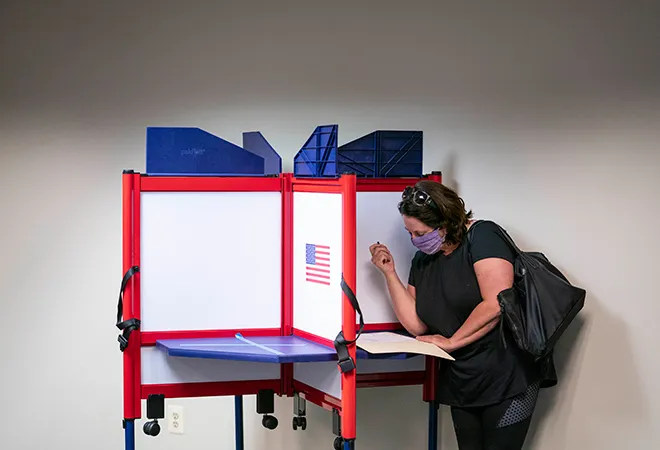
As with every presidential election since 1984, more women (58.1%) voted than men (53.8%) in 2016. This was central to Donald Trump’s victory as the major sub-electorate of white women voted 52-43 for him over Hillary Clinton — who otherwise won Black women (94-4) and Latino women (69-25). Behind Clinton’s loss of white women was the crucial subset of non-college-educated white women voting overwhelmingly (61-34) for Trump, and Clinton having a modest victory with college-educated white women (51-44).
Subsequently, that support came under question as a study of Trump’s first two years in office revealed a 13 percentage-point gender gap in his average approval rating with men and women. This was noted to be wider than his predecessors dating back to George H. W. Bush, and was apparent in the outcome of the 2018 midterm elections. In propelling Democrats to take control of the House of Representatives, they won women voters by 19 points (59-40) — a margin larger than their 1982 win (58-41). Apart from higher turnouts by women of colour and latino women, the victory was attributed to college-educated white women swinging to the left with 59 percent voting for Democratic House candidates.
However, Congressional midterms differ from presidential elections due to the Electoral College. Whereby, the outcome is determined by “a series of winner-take-all “districts”,” and not necessarily by a candidate’s vote margin. Hence in 2016, in Michigan, Pennsylvania and Wisconsin — where Trump narrowly won by 0.2, 0.7, and 0.8 percentage points, the role of non-college-educated white women had a decisive impact in handing Trump the states’ combined 46 electoral votes.
Balancing the scales against Trump’s electoral advantage
Recognising this characteristic of the US electoral system that accords “disproportionate influence to voters” such as the white working class in swing states, the campaign of the Democratic nominee and former Vice President Joe Biden seems to have crafted its strategy accordingly. Drawing on the 2018 experience, the Biden campaign has focussed on the turnout of other women voter subsets in order to outweigh any continued electoral advantage that Trump may have with the working class. This is evident in Biden’s near-consistent double-digit lead nationally, which has been underpinned by women supporters — 56 percent of whom favor Biden over 39 percent for Trump. Wherein, even as Trump reportedly continues to lead (59-37) with non-college-educated white women, Biden’s numbers are fuelled by his lead with suburban women by 14 percentage points, senior women by 12 percentage points, African American women by 72 percentage points, and women under 30 by 60 percentage points.
Further, the Biden campaign has sought a shift in voter inclinations, which has mostly occurred over the past few months with former national security officials from past Republican administrations. Popularised as ‘Biden Republicans’, the Biden campaign’s strategy to replicate such a shift with women voters is linked to its alignment with conservative political action committees like the Lincoln Project, which aims to persuade “disaffected conservatives, Republicans and Republican-leaning independents” to unseat Trump.
With help from such entities that have engaged in an advertising blitz on Trump’s handling of the coronavirus, law and order issues, and race relations, the Biden campaign has had the room to focus on women voters. By releasing its ‘Trump Has Failed American Women’ policy blueprint, the Biden campaign has highlighted the Trump administration’s actions such as, disbanding the White House Council on Women and Girls, and revoking the Fair Pay and Safe Workplaces executive order. In doing so, the campaign has sought to drive a wedge between traditional Republicans and Trump supporters, as those actions are not discussed as stemming from dogmas of the Republican Party, but as merely being reflective of Trump’s record with women.
This has helped the Biden campaign to attract conservative surrogates to complement its already impressive cohort of influential women headliners (Kamala Harris, Nancy Pelosi, Valerie Jarrett, etc). The Biden campaign has reportedly amassed help from influential ‘Biden Republican’ women like Christine Todd Whitman (former governor of New Jersey), and Susan Molinari (former congresswoman from New York). In states like Arizona — which could flip for Democrats for the first time in decades, the matriarch of the influential McCain family has also endorsed Biden. In her announcement, Cindy McCain addressed “suburban women” and asked them to “take a harder look at the race and perhaps step over the line the way I did.”
Focusing on mobilisation — and not persuasion, to repeat 2016
An alternate reading of the 2016 outcome suggests that Trump did not win because he successfully courted white voters in swing states with his nativist message. Instead, the primary factor behind Clinton’s loss could have been lower voter turnout as compared to 2012 figures. In the battleground state of Wisconsin for instance, Trump became the first Republican candidate since 1984 to win the state in a presidential election. However, Trump overall received just “about the same number of votes” as Mitt Romney in 2012, when he lost the state to Barack Obama. Whereas, Clinton “received nearly 240,000 fewer votes than Obama”. In Wisconsin, a decline in Black voter turnout from 79 percent in 2012 to 47 percent in 2016 could have alone cost Clinton about 88,000 votes — over three times Trump’s victory margin of a little over 27,000 votes.
As a result, Trump continuing to hold ground with non-college-educated women voters could then make all the difference yet again. Especially if mobilisation remains as the determinant also in view of new voter registrations plummeting across the nation due to the pandemic. Furthermore, if one were to consider the historic turnout among non-college-educated white voters during George W. Bush’s 2004 reelection, there is scope for Trump to strengthen his 2016 figures by 222,000, 175,000, and 130,000 additional voters in Michigan, Wisconsin, and Pennsylvania respectively. Hence, the Trump campaign has continued to organise large-scale rallies despite fears of the pandemic. Wherein, it has identified as much as a quarter of attendees who didn't vote in 2016, put their coordinates into a database, and then reached out to them to register to vote via follow-up door knocks, phone calls and text messages.
In order to strengthen this effort in case of non-college-educated white women, the Trump campaign has launched the ‘Women for Trump’ bus tour which seeks to boost voter turnout in the smallest of centres in distant counties of electorally-crucial states. Some scheduled stops include, New Castle (population under 88,000) in Lawrence County (Pennsylvania), Boardman (population under 35,000) in Mahoning County (Ohio), and Greenville (population under 178,000) in Pitt County (North Carolina).
To mobilise women in such places, the Trump campaign has countered the Biden campaign’s effort at making Trump’s character or policy record with women a talking-point. In doubling-down on its 2016 mantra of women voters understanding the “difference between what offends them and what affects them”, the Trump campaign has stuck to its ‘law and order' message and suggested that Biden’s policies on affordable housing would pose an existential threat to the suburbs. In addition, the campaign has hailed Trump’s decision to grant a full pardon to Susan B. Anthony — the most prominent leader of the women's suffrage movement, in face of the Left’s “cultural revolution” against such figures’ questionable legacy on race issues.
Lastly, following the death of Ruth Bader Ginsburg, the Trump campaign has highlighted the nomination of Amy Coney Barrett (Democrat legislators have criticised her as someone whose Catholic faith would influence judgements) to rally conservative Christian women. Trump’s third Supreme Court justice pick in one term, Barrett’s nomination would cement the Supreme Court’s conservative bent for generations to come. It could be particularly consequential with respect to reproductive rights, in line with Trump’s 2016 campaign pledge to nominate justices that “automatically” overturn Roe v. Wade (the landmark 1973 decision that established a woman’s legal right to abortion). From the standpoint of the election, the nomination could become a rallying point for conservative women in view of Biden’s recent shift in favor of reproductive rights — such as his reversal on the Hyde Amendment (which bars federal funding for abortions) after years of supporting it during his time in the US Senate.
Hence, unlike Biden, the Trump campaign’s strategy has not been to widen the base by pursuing women voters from across the aisle. Instead, it has sought to deepen Trump’s hold on non-college-educated white voters — and especially women in that subset, to aim for a higher turnout.
The views expressed above belong to the author(s). ORF research and analyses now available on Telegram! Click here to access our curated content — blogs, longforms and interviews.




 PREV
PREV


